|
1981 - An Air Show, Air Race and Aerobatics
As mentioned in 1979, a new fuel tank had been installed at the blister hangar to hold the fuel required for the turbo-prop Beechcraft King Air Super 200, G-HLUB. This aircraft was the latest of a series operated by the United Biscuits Aviation Department to enable its staff to oversee its many businesses. As the company expanded throughout Europe, it was realised that the Aviation Department needed to grow with it to keep up with demand for staff transport. To this end, two more aircraft were purchased in 1981, the first of these was a second Super King Air 200B, G-UBHL, a significantly upgraded aircraft from the original in terms of avionics and capabilities. The second was a smaller, but equally useful, Beechcraft King Air F90, G-BIED. At this time at least one was based at Denham.
|
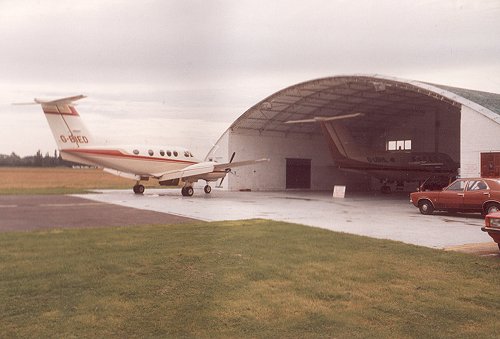
The brand new United Biscuits Beechcraft King Air F90, G-BIED, seen at the blister hangar facility in March 1981. Inside the hangar the new King Air Super 200B, G-UBHL, can be seen.
|
The acquisition of these aircraft by United Biscuits had a number of effects on the aerodrome during 1981. The first was the addition of a tarmac turning area to the end of the hard runway to allow the aircraft to turn around on the runway. The second was a reinforced grass taxiway from the hangar to the runway to provide an all-weather surface.
|
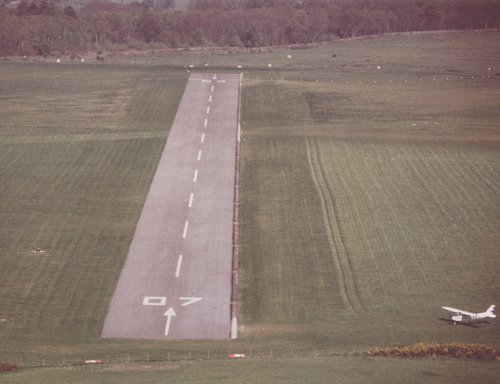
A view along the hard runway from the western end in the spring of 1981.
|
A third change to the aerodrome effected by the new arrivals was the need to extend Hangar E to accommodate them. Complex and sophisticated aircraft should not be parked in the open as the sensitive electronics can be damaged by damp conditions. The King Air required a hangar with higher door clearance than hangar E so a space was created for a purpose-built fire station between. Planning permission was sought and granted. Work on it began in March and the extension to E, now known as D, was completed in April.
|
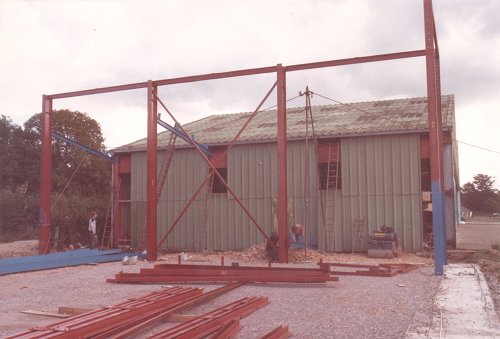
The first task in extending Hanger E was to clear the ground and prepare the foundations.
|
|

The structure of hangar D progresses.
|
|
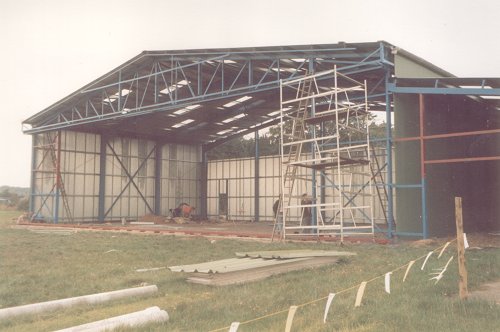
With the structure complete, the fire station and hangar D could be roofed and clad. The tracks for the doors can be seen on the lip of the concrete.
|
The 24 May saw the return of the Guild of Air Pilots and Air Navigators when Ron Gillman organised another of the popular Guild Garden Parties and Air Displays. As with previous events, this display was a mix of vintage and modern types and included a parade of superb British motor cars provided by regular participants, the Bentley Owners Club. Denham resident Phillip Meeson flew an aerobatic display in his Pitts Special and the Red Devils Army parachute team performed a low level drop. One of the rare aircraft on display was the Skandinavisk Aero Industri (SAI) KZ-VIII. This was designed by Bjorn Andreasson in 1949 for the Danish Aerobatic Team Sylvest Jensen Luftcirkus, making its debut at air displays all over Denmark in 1950. Only two more were built, one in 1959, which now resides with the Danish Museum of Flight and is still occasionally flown, and one in 1996, which is still flying. The original aircraft was sold to a Swiss owner before being brought to the UK by Robert Mitchell in 1970. He flew the aircraft for many years, but it is now believed to be in storage. Powered by a 145hp de Havilland Gypsy Major engine, the agile KZ-8 gave a spirited display of speed and aerobatics. This and many other highlights of the display are recorded below.
|
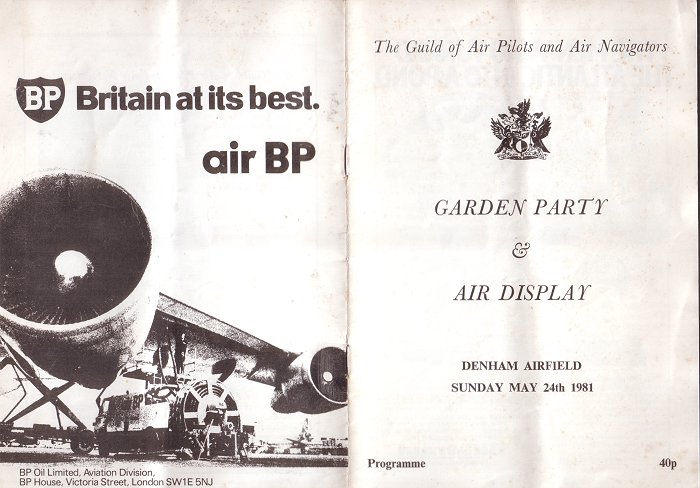
The programme for the 1981 Denham Garden Party and Air Display.
|
|
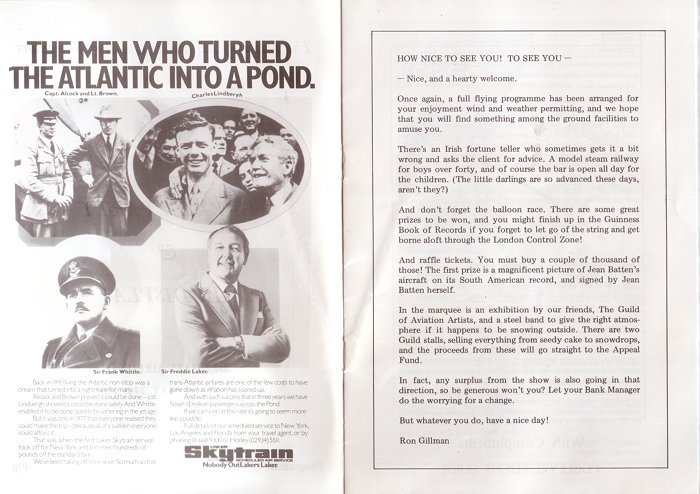
The programme for the 1981 Denham Garden Party and Air Display.
|
|
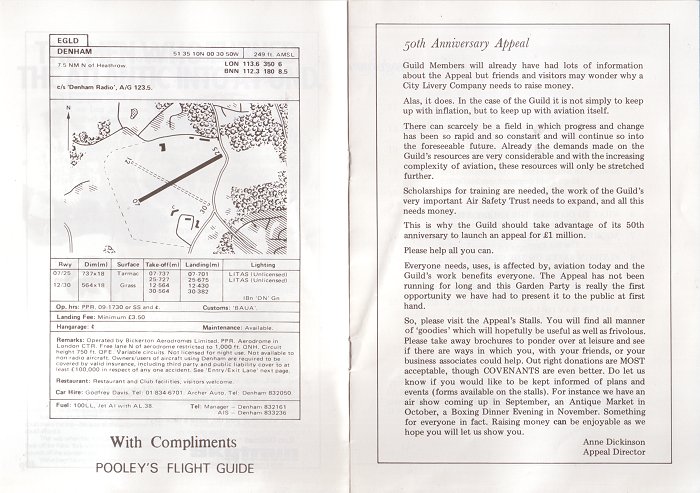
The programme for the 1981 Denham Garden Party and Air Display.
|
|
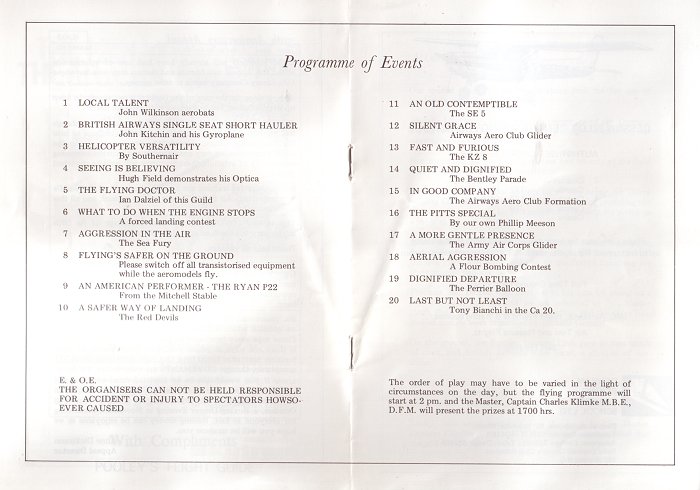
The programme for the 1981 Denham Garden Party and Air Display.
|
|
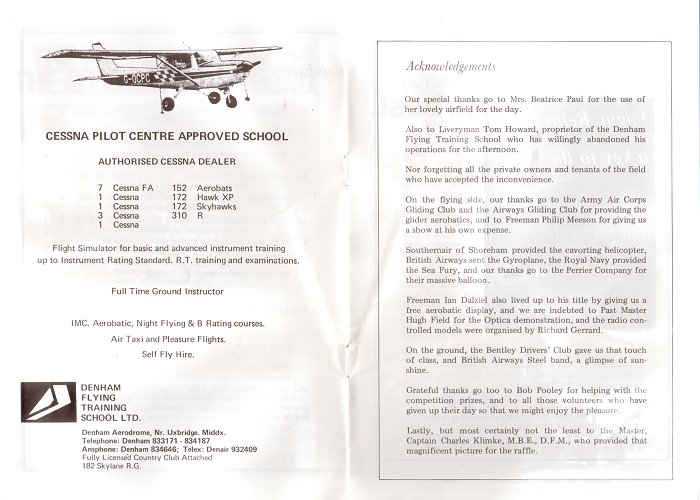
The programme for the 1981 Denham Garden Party and Air Display.
|
|
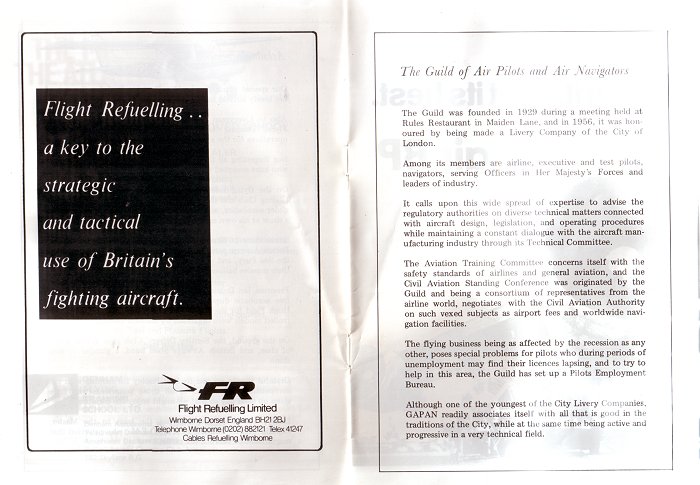
The programme for the 1981 Denham Garden Party and Air Display.
|
|
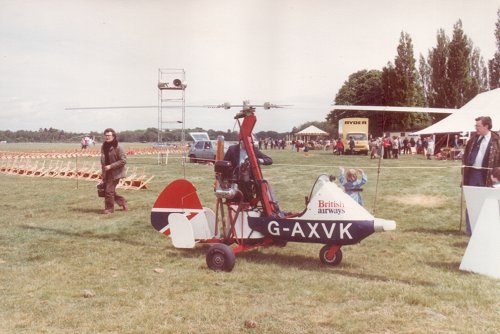
Referred to in the programme as a British Airways single seat short hauler, John Kitchin flew his Wallis Autogyro at the display.
|
|
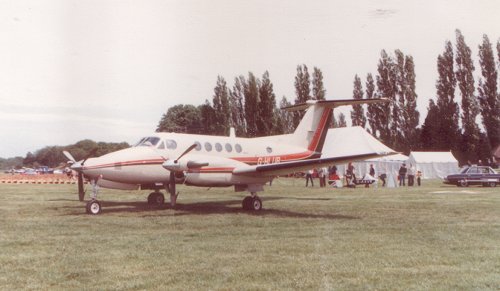
The original United Biscuits Beechcraft King Air Super 200, G-HLUB, was also part of the display.
|
|
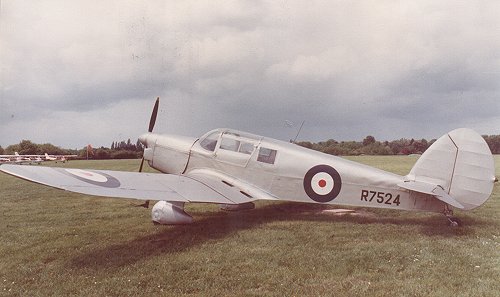
Among the visitors to the GAPAN display was this immaculate but increasingly rare Percival Proctor.
|
|
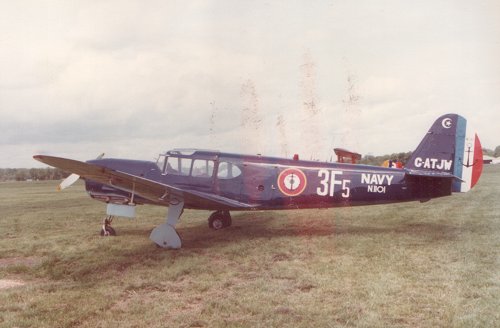
Now in a French Navy colour scheme, this Messerschmitt Me 208 had been restored at Denham by Harry Elkin and Owen Cubbit.
|
|
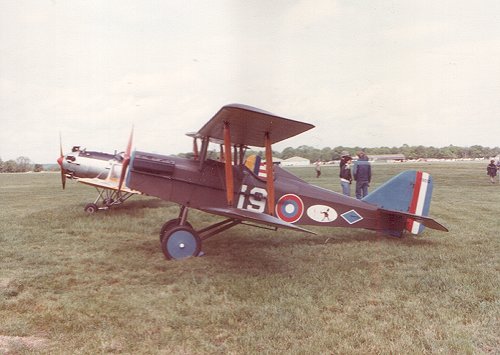
Several Royal Aircraft Factory SE.5as operated from Denham during the First World War, a fact commemorated by the appearance of this scale replica at the 1981 display.
|
|

The display also included the latest developments in aviation as evinced by this ducted fan powered Edgeley Optica.
|
|
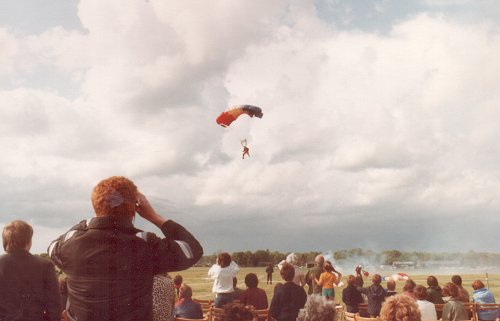
The Army's Red Devils Parachute Display Team made a precision drop right in front of the large crowd.
|
|
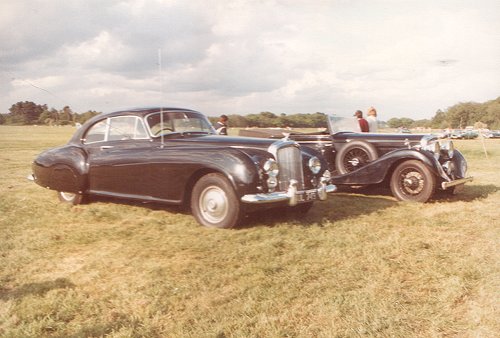
British engineering at its finest, two of the Bentley Owners Club immaculate examples that formed part of the car parade.
|
|
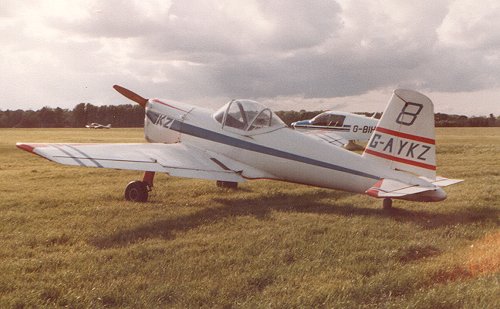
A real surprise at the display was the incredibly rare SAI KZ-VIII aerobatic and racing aircraft.
|
|

The Airways Aero Club put together this unusual formation display team flying four of their Piper Cherokees.
|
As well as taking part in the GAPAN display, Phillip Meeson and his strikingly marked Pitts S.1 Special took part in another local display on 4 July in aid of a fund raising open day at the Chalfont Centre for Epilepsy. Meeson gave his display free of charge in order to raise as much money as possible for the charity, and the day was a great success.
|
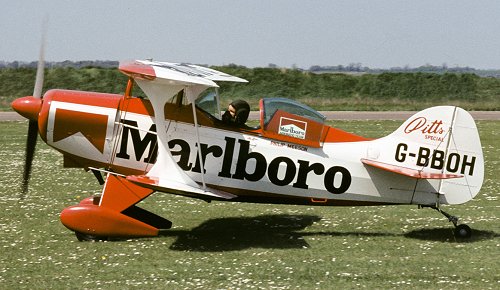
Taxying out at Denham, Phillip Meeson in his Pitts Special prepares for another display.
|
Friday 1 May saw three aircraft from the Denham flying schools depart for Bournemouth Airport, also known as Hurn. The crew of one of these was Owen Cubitt as pilot with local press photographer Paddy Hember as navigator, accompanied by two friends. Their purpose was to enter the 27th Jersey Air Rally, an event which in 1981 attracted over 70 aircraft from all over the UK and Europe. Sadly, the UK entrants were all held up by bad weather over the Channel, creating quite a traffic jam at Hurn, but by the afternoon it had cleared up enough to make the journey to the island, testing Hember's navigation skills in the challenging conditions. The three day event was marred by the weather, but much of the flying element was achieved regardless. Flying prizes were awarded by a very special guest, Sqn Ldr Brian Hoskins, the leader of the Red Arrows and the crews took full advantage of the Duty Free allowance before returning to Denham on Sunday.
|
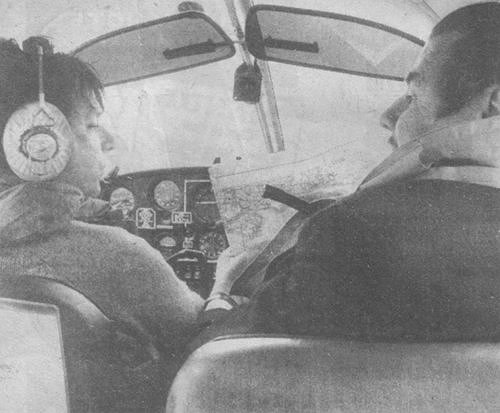
Regular Denham pilot Owen Cubbit, left, and Paddy Hember, photographer for the Bucks Free Press, seen in the cockpit of their Cherokee en route to Jersey.
|
A long time friend of Denham and a former director of the Denham Flying Club marked her retirement from flying this year. Joan Crane was by any measure a remarkable woman, having served as a nursing orderly in air ambulances with the Women's Auxiliary Air Force during the Second World War. Interestingly, Joan was actually in Berlin with her unit on the day peace was declared to end the war in Europe. After the war Joan joined British European Airways in 1946 flying in Douglas DC-3 Dakotas as a stewardess, her first aircrew uniform included her military uniform hastily dyed dark blue as rationing was still in force and clothing was both expensive and rare! Joan had always loved flying and joined the club at Denham as a student before becoming a director in 1950, both tasks handled in her spare time. After 35 years with BEA then later British Airways, Joan decided to retire at 60, and was given a choice of retirement gifts befitting the oldest aircrew member in the company. None of the list really appealed, but what she really wanted was a flight in Concorde, something she had long wanted to experience. A slot was found for her in the crew of a New York return flight, and much to her delight she was seated in the cockpit for the take-offs and landings. On her return she was given a painting of her favourite aircraft, the Dakota, which hangs in her home in Staines. This was one of many gifts from the company and her colleagues, a fitting tribute to her long career.
|
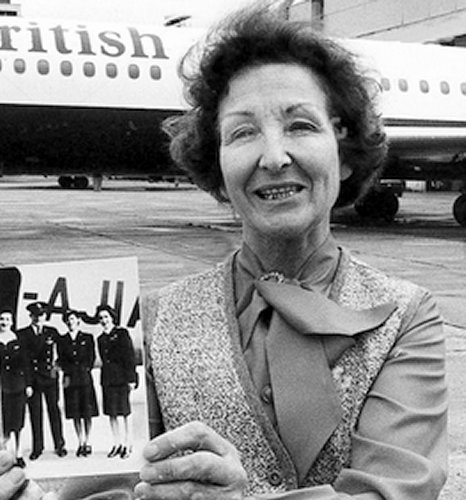
Joan Crane in front of a British Airways Trident at Heathrow with a picture of her first crew and their Douglas DC-3 Dakota.
|
Thames Valley Police held a series of trails using helicopters for a variety of police duties during 1981. An Aerospatiale AS350 Single Squirrel from McAlpine Helicopters was used for the 75 hours of test flying over six weeks, flown by Arthur Burland with many of the flights using Denham as a base or to refuel. Chief Inspector Alan Englefield was the senior officer in charge of the trials and was impressed by the results. In one example an area of rough ground near Newport Pagnell was searched in an hour at a cost of around £200. Due to the inaccessible nature of the search area, to achieve the same thing on the ground would have required around 200 police officers for a week, a tremendous saving in both cost and resources. It was the cost effectiveness of the helicopter in applications as varied as traffic control, area search and crime prevention and detection that resulted in a very positive report from all of the officers involved in the project.
|
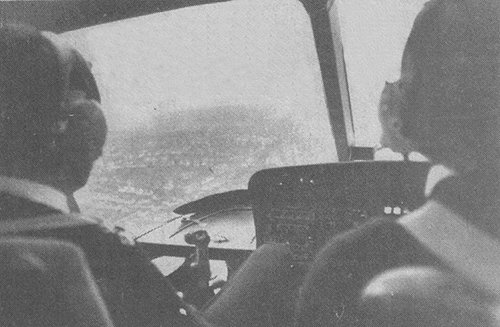
Chief Inspector Alan Englefield of Thames Valley Police and Captain Arthur Burland of McAlpine helicopters over West London during the 1981 trials.
|
As you can see, 1981 was a very busy year for the aerodrome, but more was to come in the next few years. There were to be changes in the companies at Denham as well as the flying schools, as will be related next.
|
|

